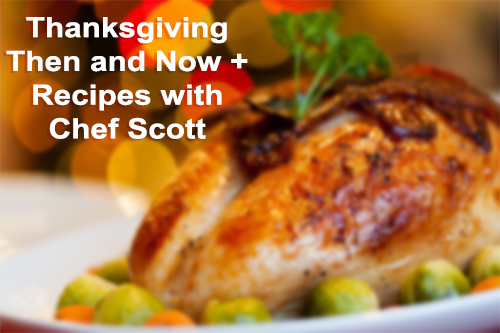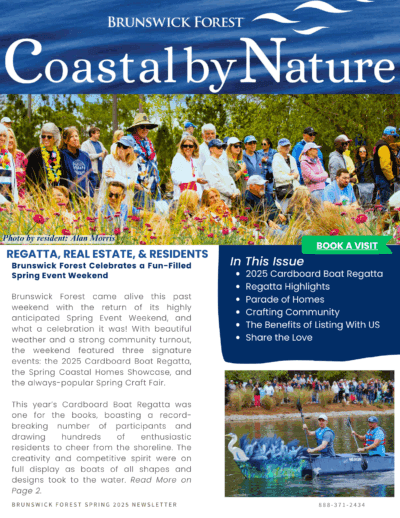Thanksgiving Then and Now: Recipes and Tips with Chef Scott

Thanksgiving is a truly special time of year, and one that we value here at Brunswick Forest. The Brunswick Forest team is super thankful for our community, building partners and residents that live here. Thanksgiving is a great time of year where you can sit around the table and truly indulge in all the kitchen has to offer. You think of Thanksgiving meals and images of corn bread, roasted turkey and cranberry sauce instantly come to mind. What you might be interested in knowing however, is that the meals eaten at the first Thanksgiving were most likely radically different than what we’re used to today.
According to history, Puritan Pilgrims fled Europe for the New World in the 1600s and made landfall over in what is current day Massachusetts. There they established the Plymouth colony and did their best to carve out a new lifestyle. With the help of befriended Native tribes, the colonists managed to reap their first harvest in 1621. After the success of outlasting the harsh conditions there, the colonists held a massive harvest feast at Plymouth, and invited the natives who helped them. What is known about the first Thanksgiving, is that it was mostly religious in nature and hundreds of people were thought to gather for the celebration. Turkey, duck, geese and even swans were served at the first Thanksgiving! Fish and shellfish were also served along with dried fruits, squash, beans and dried maize. It was theorized that most of the sugar brought over on the Mayflower was nearly exhausted by the time this event took place, so delicacies like wheat pudding were one of the only sweet treats served. It’s a bit of a difference from the pies, cakes and breads that most Americans are used to having. Most of the pilgrims didn’t have access to stoves and modern cooking techniques! Despite the differences of table fare, one key element has remained consistent over the centuries; being thankful for what you have is what Thanksgiving is all about.
That’s not to say a good recipe for a mouthwatering Thanksgiving treat isn’t still appreciated! Thanksgiving meals can consist of many delectable items, all of which take a lot of time to prepare, organize and serve! Luckily for you, Brunswick Forest’s Chef Scott Euvrard has a few tips that will make your Thanksgiving preparations a whole lot easier in the kitchen.
Some of you might have heard of the practice of “brining” your turkey, while some of you may not have. Simply put, the art of brining involves creating a brine solution that contains salt, herbs and spices. A turkey can then be “bathed” in the brining solution for an extended period before being cleaned and roasted. “Brining your turkey might sound intimidating, but it’s very easy once you have the tips for getting the process down,” Chef Scott tells us. “The number one issue at home is having enough room to submerge a turkey and how to fit it in your fridge. My suggestion is using a cooler, as it will stay chilled and you can leave it right in the garage if need be,” he continues. The result of the brining process is a much juicier bird that is loaded with flavor! Here are some basic ingredients that you will need to make a fantastic brine:
- Three cups of apple cider
- Two cups of brown sugar
- One cup of kosher salt
- Three tablespoons of tricolor peppercorns
- Five whole bay leaves
- Five cloves of minced garlic
- Four sprigs of rosemary with leaves stripped off
- Orange peel gathered from three large oranges
- One turkey
Stir everything together to dissolve the sugar in the brine, and then bring to a boil to dissolve salt. Make sure you let the brine cool completely before placing your turkey in the brine bath. Place your turkey in a 12qt cooler or whatever you have, pour brine over the turkey and add enough ice so that the turkey is submerged. Proceed to close the lid and let the bird soak in the brine overnight. The next day, be sure to rinse the turkey off and begin your day of preparation to cook the bird.
For those looking for something delicious and unique, Chef Scott offers this great recipe for a mushroom strudel. “The best part about this recipe is that it’s very simple, but the result looks like it came from a five-star hotel!” Here’s what you will need:
- One package of phyllo dough
- Two pounds of assorted sliced mushrooms
- One clove of garlic
- One shallot
- Half a cup of sherry wine
- One cup of parmesan cheese
- One cup of breadcrumbs
- Half a stick of butter melted
- Chopped parsley
First, be sure to slice the mushrooms you’ve gathered and sauté them with the garlic and shallot in two tablespoons of olive oil; do this until all the water has drained away, and then begin to add in your sherry wine. Reduce the wine by half and then add in the half cup of parmesan cheese along with the breadcrumbs you’ve gathered. Stir these along with the mushrooms to create a stuffing-like mixture that will serve as your strudel filling. You can put the mushroom mix in a cooler and chill it for about an hour or until it is completely cold. Next, you’ll want to begin working the phyllo dough one sheet at a time, brushing it with butter as you do so. Next, sprinkle in some breadcrumbs, parsley and parmesan cheese just enough to coat the entire sheet. You can continue this process until you have about 10 to 12 layers of dough. Take your mushroom filling out of the fridge and pile it at one end of the dough, then roll the dough around the mushroom mixture, like you would a burrito. Be sure to brush the strudel with butter and cut slits into the top to allow steam to escape. Cook the strudel in an oven that is preheated to 400 degrees for 15-20 minutes and appears golden brown. Let the strudel cool, cut it into pieces and serve!






